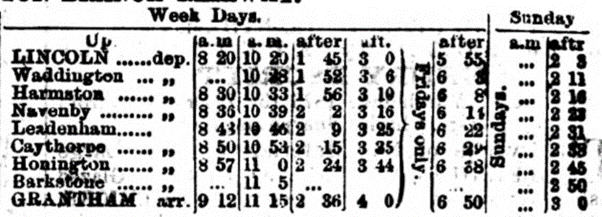How did people in local villages get about in 1873?
Roads
Apart from the A1, the local road network in the 1870s wasn’t that different to today. Originally, they’d been maintained by each parish, but the 1862 Highways Act had transferred the responsibility for most roads to the County Surveyor.
Roads would have been made using (to some degree) Macadam techniques, such as medium-sized stones at the bottom and smaller stones on top. They’d be dusty in dry weather as they wouldn’t have been sealed with tar (tar-macadam, i.e. ‘tarmac’) until the 20th century.
People without their own horse would have relied on the railway (see below) or local carriers. The latter were men with horse-drawn wagons who provided a regular service, usually just on market days, from the villages to the towns, and then back later the same day. A better service than many villages enjoy today; and they always dropped off and collected at a pub! In 1873 the carriers to/from Grantham (and their drop off point) included:
- Barkston – Mr Shelbourn (Saturdays, Fox & Hounds)
- Brant Broughton– Mr Peck (Saturdays, Fox & Hounds)
- Caythorpe – Mr Codd (Saturdays, Blue Pig) / Mr Baker (Daily, Angel and Royal) / Mr Walker (Saturdays, Rose & Crown)
- Claypole – Mr Blundy (Saturdays, Black Dog)
- Foston – Mr Johnson (Saturdays, Blue Lion) Dickenson (Saturdays, Granby Inn)
- Fulbeck – Mr Baker (Daily, Angel & Royal), Picker (Satudays, Rose & Crown)
- Gelston – Mr Pratt (Daily, Blue Pig)
- Hough – Mr Shelbourn (Saturday, Blue Pig)
- Marston – Mr Bilson (Wednesday & Saturday, Blue Lion)
Railways
In the 1870s there were two railways through the district. The Great Northern Main Line is still in use (as the East Coast Main Line) but it had stations at Barkston, Hougham and Claypole. Here is the morning timetable for up (London-bound) trains in 1873.
The 10:56am slow train from Claypole didn’t get to London until 3:35pm. So, to get to London, it would have been faster to get off at Grantham, have an early lunch, and catch the 1240 fast train, which reached Kings Cross 2½ hours later.

The other railway was the Great Northern’s Lincoln to Honington branch line. It had stations at Waddington, Harmston, Navenby, Leadenham, Caythorpe, Honington and Barkston; before connecting to the Boston line and on to Grantham. Here is the 1873 ‘up’ timetable.
As noted in the section on ironstone mining, the line was finally closed in 1965.
